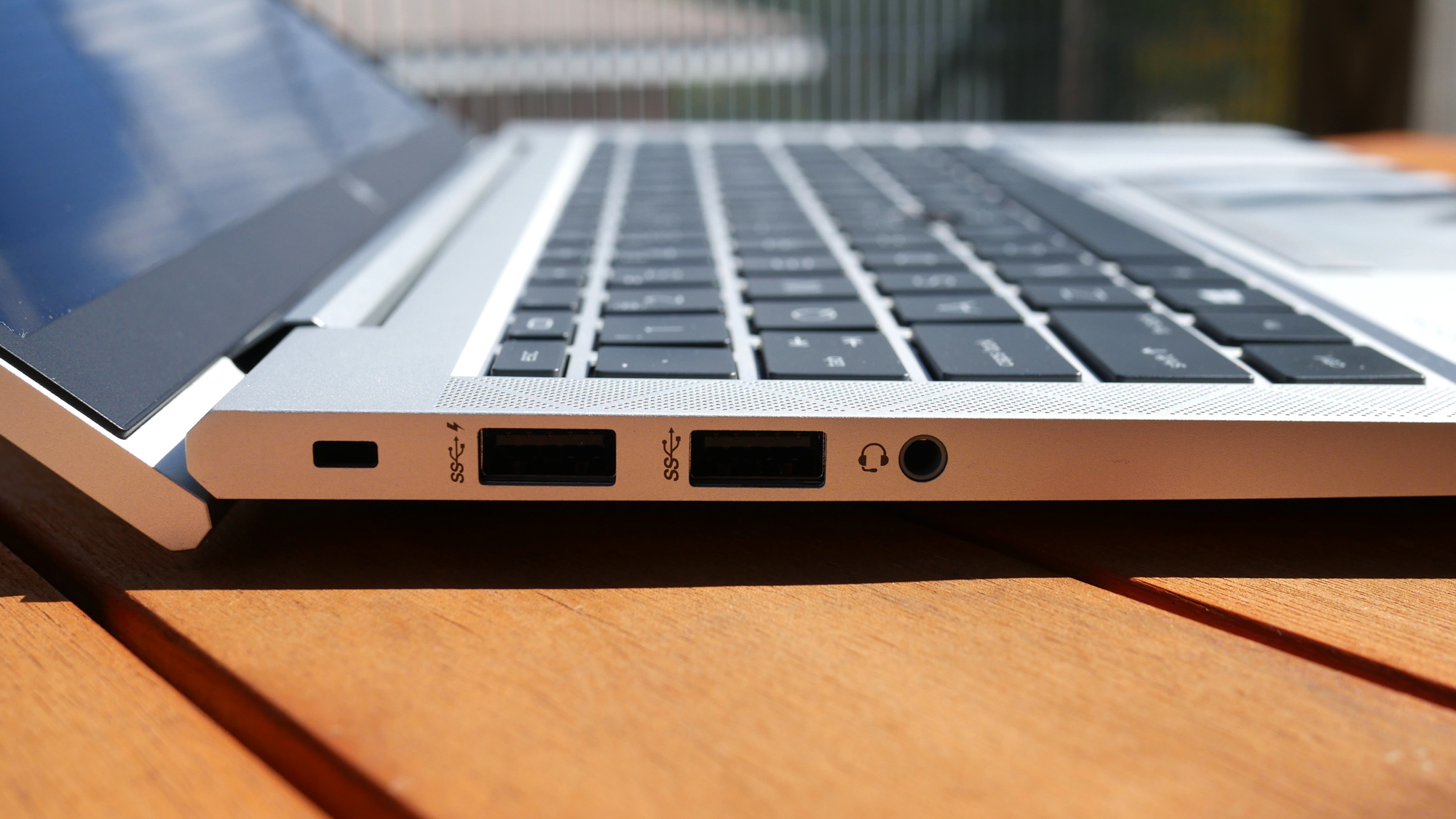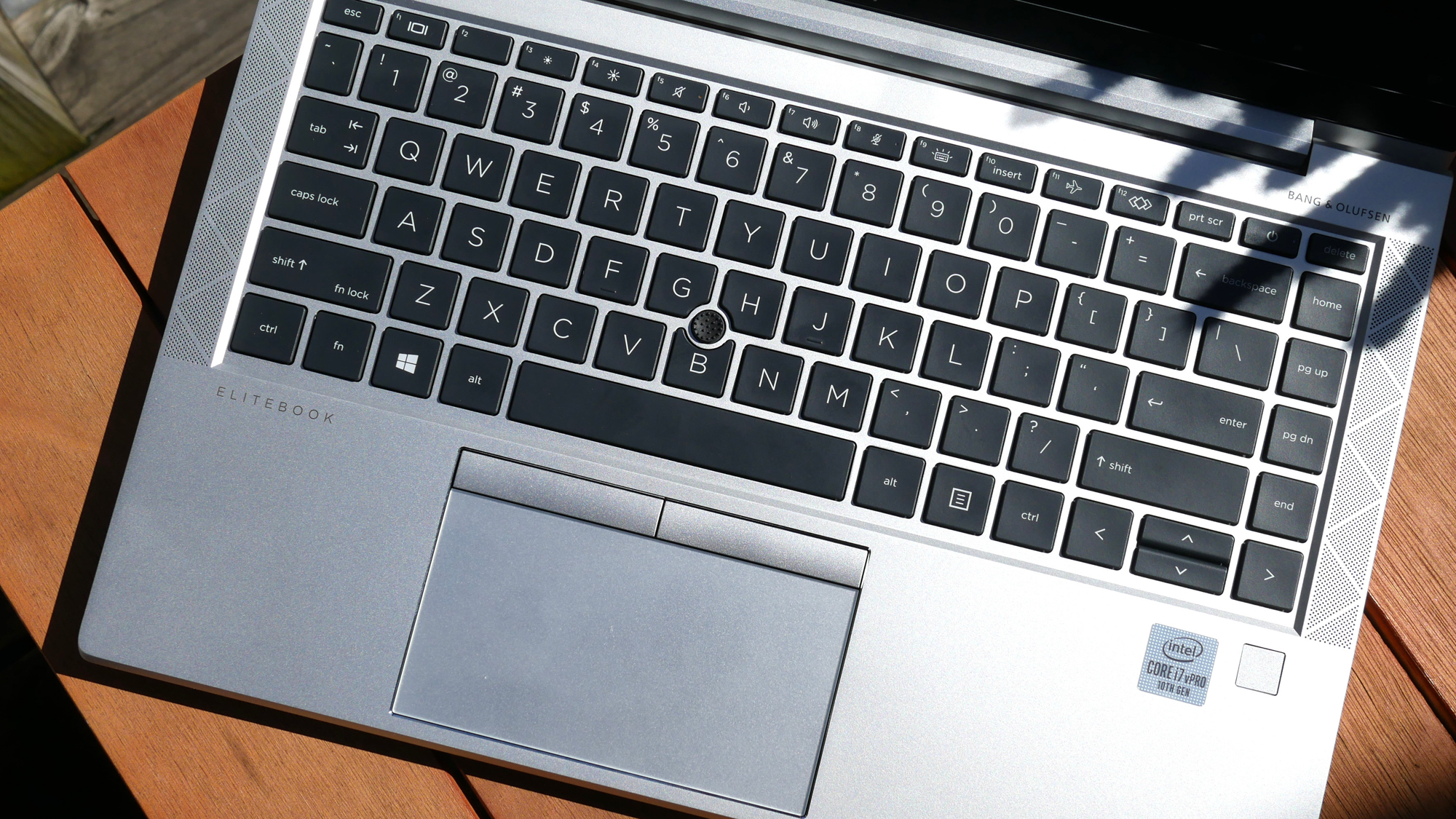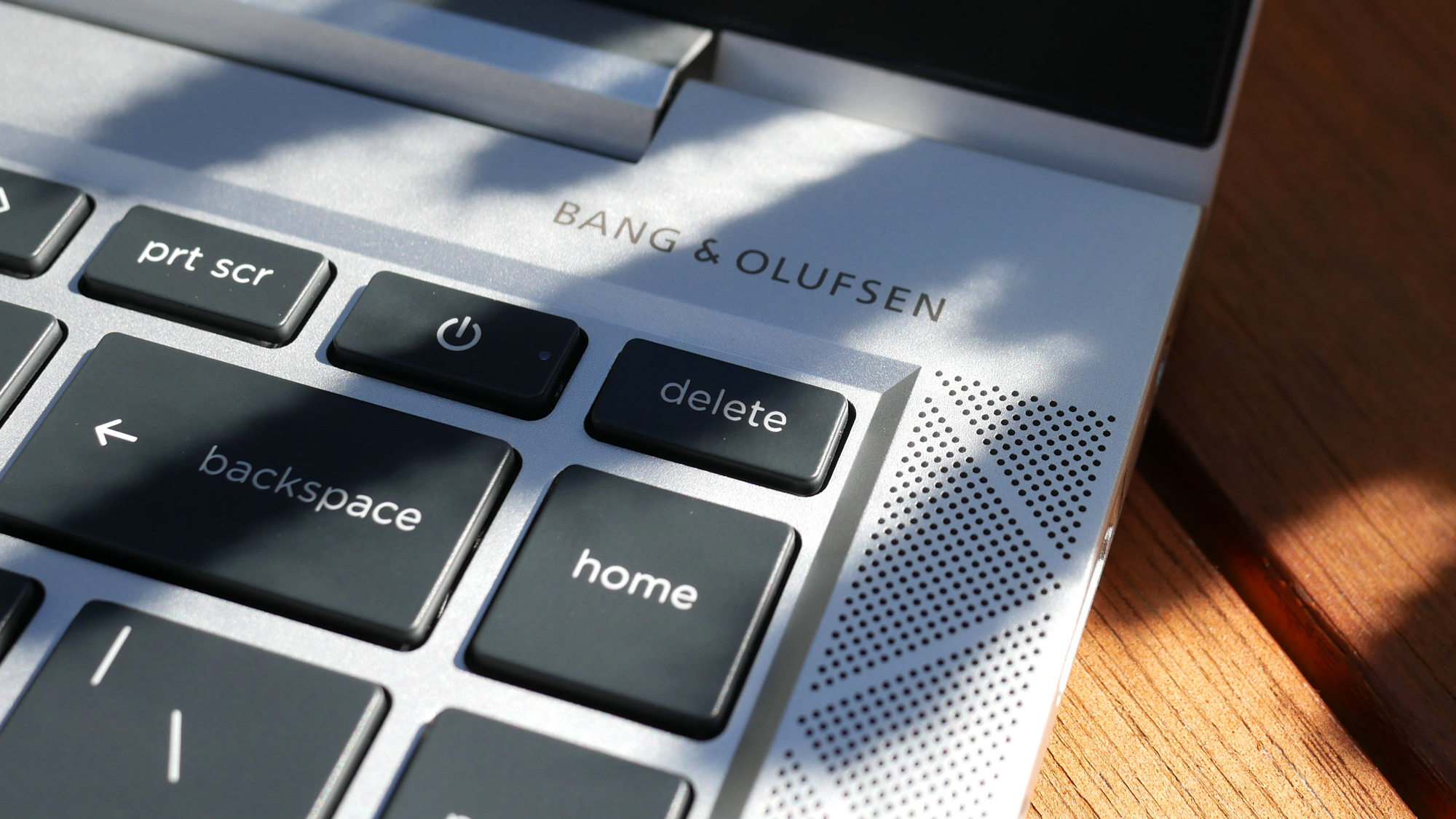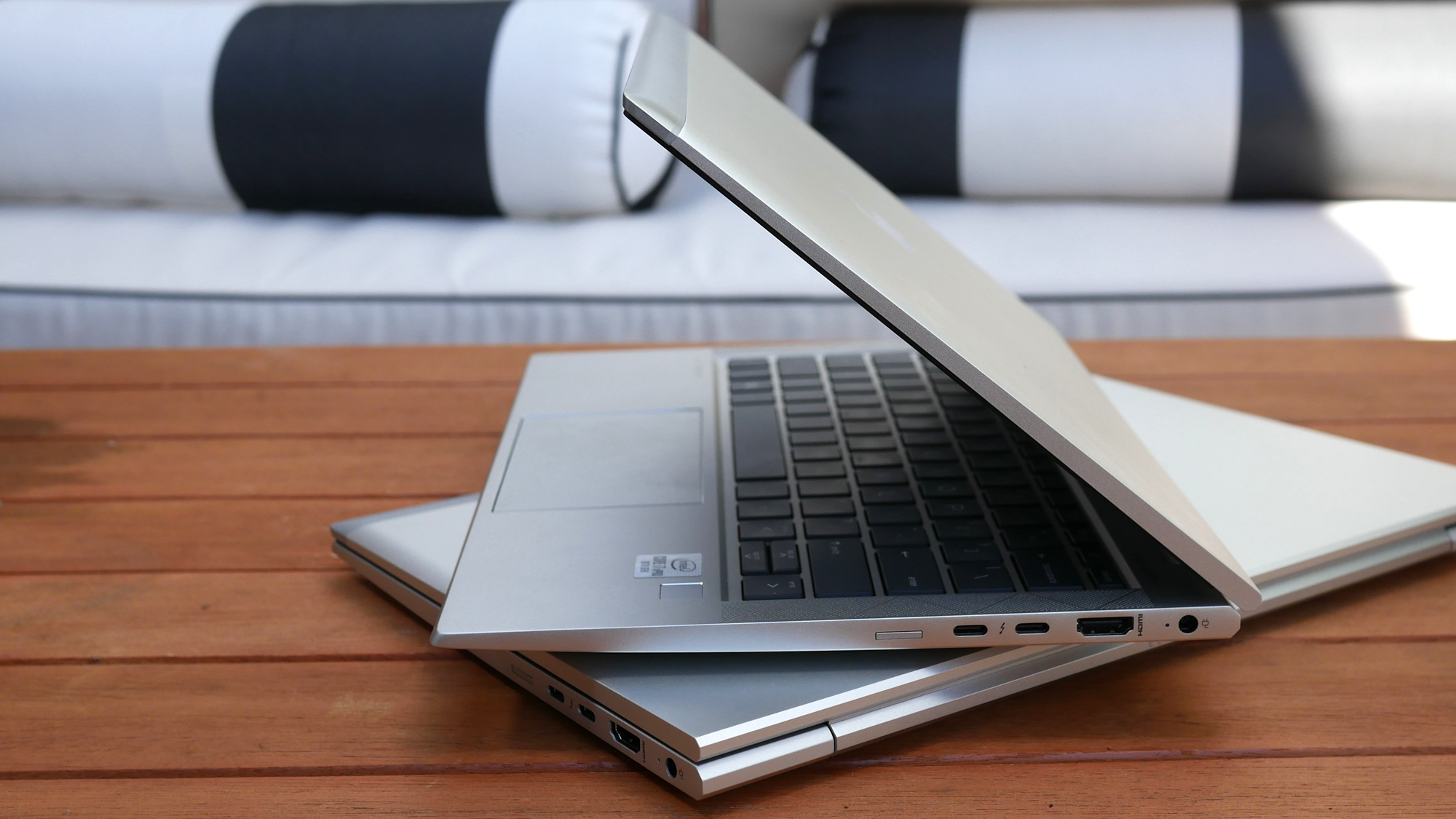Laptop Mag Verdict
HP's EliteBook 830 G7 and 840 G7 have few weaknesses, making them great alternatives to the ThinkPad X1 Carbon.
Pros
- +
Sleek aluminum chassis
- +
Fast performance
- +
Comfortable keyboard
- +
Plenty of ports
- +
Modern security features
Cons
- -
Weak graphics
- -
Top configs are expensive
- -
Ho-hum webcam
Why you can trust Laptop Mag
Price: $2,099 (EliteBook 830); $2,199 (EliteBook 840)
CPU: Intel Core i7-10810U CPU
GPU: UHD graphics
RAM: 16GB
Storage: 512GB SSD
Display: 13.3-inch, 1080p; 14-inch, 1080p
Battery: 9:45 (EliteBook 830); 9:23 (EliteBook 840)
HP's Elitebook 800 series can be seen as the Envy equivalent of its business laptops. The idea behind the line is to provide premium features adopted from the flagship EliteBook 1000-series notebooks at a lower price without cutting too many corners. In most ways, the EliteBook 830 G7 and 840 G7 are successful in accomplishing that goal.
As is the case with most new HP systems, the highlight of these laptops is their sleek aluminum chassis, which smartly blends form with function. Looking past the frame, these two EliteBook models get you a solid 1080p display, fast performance, a bevy of security features and a comfortable keyboard — everything you need to finish projects at work or relax after you clock out.
EliteBook 830 and EliteBook 840 G7 price and configuration options
We're bundling the EliteBook 830 and EliteBook 840 G7 into a single review because they're practically identical once you ignore screen size.
Starting with the 13-inch model, the EliteBook 830 G7 has a base price of $1,369 when configured with a 1080p display (250 nits), an Intel 10th Gen Core i5-10210U CPU, 8GB of RAM and a 256GB PCIe NVMe SSD. Stepping up to an Intel Core i7-10610U CPU along with 32GB of Intel Optane memory raises the price to $1,768.
Our review unit costs $2,099 and comes with a 1080p display (400 nits), a Core i7-10810U vPro CPU, 16GB of RAM and a 512GB SSD. There are tons of other configuration options to consider. I played around on HP.com and configured myself a $3,202 model with a 1080p Sure View display (1,000 nits), a Core i7 vPro CPU, 64GB of RAM and a 1TB PCIe NVMe SSD.
The 14-inch EliteBook 840 G7 is a tad pricier. The larger model starts at $1,349 and comes with a 1080p, 250-nit display, a Core i5-10210U CPU, 8GB of RAM and a 256GB SSD. Our $2,199 unit was configured with the same specs as our 830 G7: a 1080p, 400-nit panel, a Core i7-10810U vPro CPU, 16GB of RAM and a 512GB SSD.
EliteBook 830 and EliteBook 840 G7 design
I want HP's designers to redo my wardrobe because they have a serious eye for style.
The EliteBook 830 and EliteBook 840 G7 defy the business laptop stereotype, proving that a laptop doesn't need to be chunky and bland to get work done. Borrowing some of the best Spectre x360 traits, the EliteBook 830 and 840 have a sleek silver aluminum chassis that blends a modern aesthetic with traditional business features.

These two notebooks might not catch your eye at first glance but a closer look reveals several thoughtful additions. The stylized chrome HP logo looks great centered on the lid, but it's the angled spine adorned with an EliteBook logo and the chrome-trimmed touchpad that give these laptops an added sophistication.
Begone, bezels! HP trimmed down the bezels on these latest models by up to 39% to achieve an 85% screen-to-body ratio. It's not just about removing those ugly black borders but decreasing the overall footprint of the laptop. To that end, the EliteBook 830 G7 and 840 G7 are 11.5% and 9% smaller than their predecessors, respectively.

HP didn't only design these EliteBooks models for good looks. The tapered front edge of the lid makes the EliteBook 830 and 840 easier to open with one finger while the stylish, triangle-patterned speaker grilles on the deck push sound toward your ears for an unobscured listening experience. Also, on the deck is a fingerprint sensor and a generously sized touchpad (more on that later).
At 12.1 x 8.1 x 0.7 inches, the 2.8-pound EliteBook 830 G7 is predictably smaller and lighter than the EliteBook 840 G7 (12.74 x 8.45 x 0.7 inches, 3 pounds) and the Dell Latitude 7410 (12.7 x 8.2 x 0.76 inches, 2.9 pounds) but even the 13-inch model weighs more than the featherweight Lenovo ThinkPad X1 Carbon (12.7 x 8.5 x 0.6 inches, 2.4 pounds).
EliteBook 830 and EliteBook 840 G7 durability and security
These latest EliteBook models are protected on the inside and out. Having passed 19 military-grade durability tests, the EliteBook 830 G7 and 840 G7 should be capable of withstanding extreme conditions, like high altitudes or scolding temperatures.

Unfortunately, I have some durability concerns of my own. The EliteBook 830 G7 unit HP sent me makes a loud clicking sound when I press gently on the bottom panel. It sounds like something isn't snapped into place properly.
Protecting your privacy is a fingerprint sensor on the deck and an IR camera above the screen. That webcam can be easily hidden by sliding over a lens cover. What you can't see is a TPM 2.0 chip, which ensures all data is encrypted before it gets transferred. You also get HP's comprehensive suite of security software from Secure Erase (erases HDDs and SSDs for recycle) to HP Sure Start (BIOS attack detection).
EliteBook 830 and EliteBook 840 G7 ports
Business users won't need dongles or a dock to connect to peripherals thanks to the generous array of ports on these notebooks.

The EliteBook 830 G7 and EliteBook 840 G7 offer the same ports. On the left side are two USB 3.1 Type-A inputs, a headphone/mic jack, a Smart Card reader and a Kensington lock.

Turning to the right side, you'll find two Thunderbolt 3 ports, an HDMI 1.4 input and a SIM card slot for LTE connectivity.
EliteBook 830 and EliteBook 840 G7 display
There is no 4K option for either laptop but the 1080p panels on the EliteBook 830 and EliteBook 840 G7 are great — so long as you opt for the 400-nit panel.

The displays on these two laptops look similar although the EliteBook 930's 13-inch, 1080p panel had a cleaner white balance out of the box compared to the slightly murky yellow hue on the EliteBook 840 G7's 14-inch, 1080p display. With either panel, you can expect a sharp, vivid picture you'll appreciate in video chats with your boss or when you're streaming TV shows after you punch out for the day.
In a trailer for Top Gun: Maverick, I could see the Navy logo in sharp detail on the side of a plane in mid-barrel roll. I saw the wrinkles around Tom Cruise's eyes just above his sun-tanned cheeks. The red stripes on his helmet popped against the monochrome cockpit and light blue sky similar to how the ribbons stood out against the Navy service khaki uniforms. Again, these displays are almost identical, but the snow-capped mountains had a purer white hue on the 13-inch laptop.
According to our colorimeter, the EliteBook 830 G7's panel covers 79% of the DCI-P3 color gamut whereas the EliteBook 840 G7's screen captures 78%. The Latitude 7410 has a more vivid display, at 83%, while the ThinkPad X1 Carbon's 1080p panel is duller (78%). The premium laptop average is 83%.
You won't have problems using the EliteBook 830 G7 and 840 G7 outside, even on bright days. The 13-inch display reached 374 nits of maximum brightness, just short of the peak brightness on the 14-inch model (378 nits). Again, the Latitude 7410 (402 nits) edges out the competition while the ThinkPad X1 Carbon (364 nits) was a bit dimmer than the rest and the 382-nit category average.
EliteBook 830 and EliteBook 840 G7 keyboard and touchpad
Between Lenovo's ThinkPads and these EliteBooks, you might want a business laptop for the keyboard alone. I can only think of a few portable laptops as comfortable to type on than these EliteBooks.

It's the combination of large keys and deep travel that make the EliteBook 830 and EliteBook 840's backlit, Chiclet-style keys such a pleasure to use. There is a hefty "click" each time your fingers activate a key followed by a spinginess that lifts your fingers up so they can move to the next letter.
I don't have any issues with the layout, either. In our current remote working climate, it's nice to have video conferencing controls on the shortcut row so you can quickly mute yourself. And while not everyone at Laptop Mag is a fan of the font, I really like the bold oversized figures on the key caps.
I typed at 115 words per minute with a 94% accuracy on the 10fastfingers.com typing test, results that are just short of my usual 119-wpm, 95% accuracy averages.
While the typing experience feels identical between these two notebooks, there are some key (pun intended) differences between the 13- and 14-inch models. With its wider footprint, the 840 G7 has room for a few extra keys including a separate row for page up/down, home and end. There is also a right-click key not found on the 13-inch model. Also on the EliteBook 840 G7 is a rubber pointing stick and accompanying left- and right-click buttons above the touchpad.

These features are absent on the 13-inch model so if you prefer the rubber nub over the touchpad, go with the EliteBook 840 G7. Speaking of the touchpad, the 4.4 x 2.4-inch surface responded to my taps and swipes, executing gestures like pinch-to-zoom and two-finger scrolling.
EliteBook 830 and EliteBook 840 G7 audio
Even without a quad-speaker setup, the EliteBook 830 G7 and 840 G7 produced good crisp audio when I played The Neighborhood's "Pretty Boy." High notes were clear without sounding tinny on the treble-heavy song, and the vocals were forward. The sound wasn't quite loud enough to fill my large living room, but you don't need to keep the laptops at 100% volume when sitting directly behind them.

The Bang & Olufsen-tuned speakers lacked bass when I played Regard's "Ride It" but the clarity of the electronic instruments was satisfying.
EliteBook 830 and EliteBook 840 G7 performance
Powered by an Intel 10th Gen Core i7-10810U CPU and 16GB of RAM, the EliteBook 830 and 840 G7 handled everything I threw at them. My punishing workload involving no less than 30 Google Chrome tabs wasn't a problem for either system. I played a couple of 1080p YouTube videos while streaming the Champions' League draw and didn't notice even a hint of sluggishness.

This dynamic duo flexed all over the competition in our synthetic benchmark tests, with the EliteBook 830 scoring a 4,262 and the 840 G7 notching a 4,378. The Latitude 7410, equipped with an Intel Core i7-10610U, proved with its 3,108 result that splurging on the top-tier CPU variant pays off. Equipped with the same Core i7-10610U CPU, the ThinkPad X1 Carbon (3,913) closed the gap a bit but only the EliteBooks topped the category average (4,037).
With so much power to work with, it's no wonder the EliteBook 830 and 840 G7 had no problems converting a 4K video to 1080p using the Handbrake app. It took the 13-inch model 17 minutes and 12 seconds and the 14-inch version 15 minutes and 29 seconds. Rival laptops in the Latitude 7410 (22:34) and X1 Carbon (19:51) needed several additional minutes to complete the same task.
Transferring files won't take long on these EliteBooks thanks to their speedy SSDs. The 840 G7's 512GB NVMe PCIe SSD took 52 seconds to convert a 25GB multimedia file equating to a transfer rate of 574.9 megabytes per second. The smaller model was a tad slower at 433.9 MBps. I maintain that those are good times, but only the 14-inch EliteBook topped the category average (566.4 MBps) and even it lost out to the X1 Carbon (1,044.7 MBps) and Latitude 7410 (574.9 MBps).
EliteBook 830 and EliteBook 840 G7 graphics
I hope this is the last laptop I review with UHD graphics. A new era of integrated graphics, led by Iris Plus and Iris Xe, means the UHD graphics in the EliteBook 830 and EliteBook 940 G7 just won't cut it when new models arrive.
The feeble graphics managed to run Sid Meier's Civilization VI: Gathering Storm at an unplayable 12 frames per second on the EliteBook 840 and 11 fps on the 13-inch model. If it's any consultation, and it really shouldn't be, the X1 Carbon (8 fps) and Latitude 7410 (9 fps) somehow fared worse. The average premium laptop can play this game at 25 fps.
EliteBook 830 and EliteBook 840 G7 battery life
You can expect about a full day of battery life from these laptops. The EliteBook 830 G7 lasted for 9 hours and 45 minutes on our battery test (continuous web surfing over Wi-Fi at 150 nits), just 22 minutes longer than the EliteBook 840 G7 (9:23).

Those are good if unremarkable runtimes. Dell's Latitude 7410 (10:56) and the ThinkPad X1 Carbon (10:45) both broke the 10-hour mark and the category average (10:01).
EliteBook 830 and EliteBook 840 G7 webcam
You need perfect lighting conditions to get a good image from the EliteBook 830 and 840 G7's 720p webcam. A selfie I snapped in my dimly lit apartment was a noisy mess. My face became more clear as I neared a window but my skin still looked blotchy. The camera at least captured the reddish hues in my cheeks and the dark blue of my shirt. It's good enough in a pinch if your home or office is well lit, but any other setup would benefit from an external webcam.
EliteBook 830 and EliteBook 840 G7 heat
The EliteBook 840 didn't overexert itself in our heat test but the EliteBook 830 had some trouble keeping its cool.
The bottom panel on the 13-inch model reached 99 degrees Fahrenheit after we played a 15-minute, 1080p video. Fortunately, the center of the keyboard (90 degrees) and the touchpad (79 degrees) stayed below our 95-degree comfort threshold.
Pushing the EliteBook 840 G7's engine didn't cause it to overheat; the laptop warmed to only 92 degrees and the keyboard and touchpad stayed at a comfy 86 degrees and 78 degrees, respectively.
EliteBook 830 and EliteBook 840 G7 software and warranty
Holy bloatware! OK, it's not all bloatware, but when I opened the Start Menu on the EliteBook, I was bombarded with a baker's dozen of HP apps. Please HP, for the last time (I know it won't be), find a way to package these together because it's unwieldy at this point.

I won't go into detail on every app HP includes, but it's worth spotlighting a few. For instance, HP Workwell prompts you to exercise at times and gives you insight on your work patterns. I get it HP, this lifestyle ain't healthy.
HP Sure Click is a threat-alert software while PC Hardware Diagnostics (along with needing a more creative name) gives you a rundown of how your PC is performing. There's also a power management app, a separate app with documentation, another for support and a JumpStart program for getting your system setup.
But wait, that's not all. Also pre-installed on the EliteBook 830 and 940 are a couple of Intel management programs along with the standard stock of Microsoft apps that appear on all Windows 10 Pro systems.
HP ships the EliteBook 830 G7 and EliteBook 840 G7 with a three-year warranty. See how HP fared on our Tech Support Showdown and Best and Worst Brands special reports.
Bottom line
Rarely do I review a laptop with as few shortcomings as the EliteBook 830 G7 and EliteBook 840 G7, and yet, I'm not entirely sold. Yes, these systems nail the basics, but they fail to stand out in any way. While they offer a sleek design, a good 1080p display, fast performance and decent battery life, the EliteBook 830 and 840 G7 don't do anything to separate themselves from the competition.
That doesn't mean they aren't the best options. In fact, at the right price, I'd even consider these models over the ThinkPad X1 Carbon, our long-standing best business laptop. It ultimately comes down to pricing -- if you can find these on sale for less than their rivals, then don't hesitate to snag them for your workforce — they'll be happy with their new systems, trust me.
EliteBook 830 and EliteBook 840 G7 Specs
| Display | 13.3-inch, 1080p; 14-inch, 1080p |
| CPU | Intel Core i7-10810U CPU |
| Price | $2,099 (EliteBook 830); $2,199 (EliteBook 840) |
| GPU | UHD graphics |
| Battery | 9:45 (EliteBook 830); 9:23 (EliteBook 840) |
| Storage | 512GB SSD |
| RAM | 16GB |
Phillip Tracy is the assistant managing editor at Laptop Mag where he reviews laptops, phones and other gadgets while covering the latest industry news. After graduating with a journalism degree from the University of Texas at Austin, Phillip became a tech reporter at the Daily Dot. There, he wrote reviews for a range of gadgets and covered everything from social media trends to cybersecurity. Prior to that, he wrote for RCR Wireless News covering 5G and IoT. When he's not tinkering with devices, you can find Phillip playing video games, reading, traveling or watching soccer.


